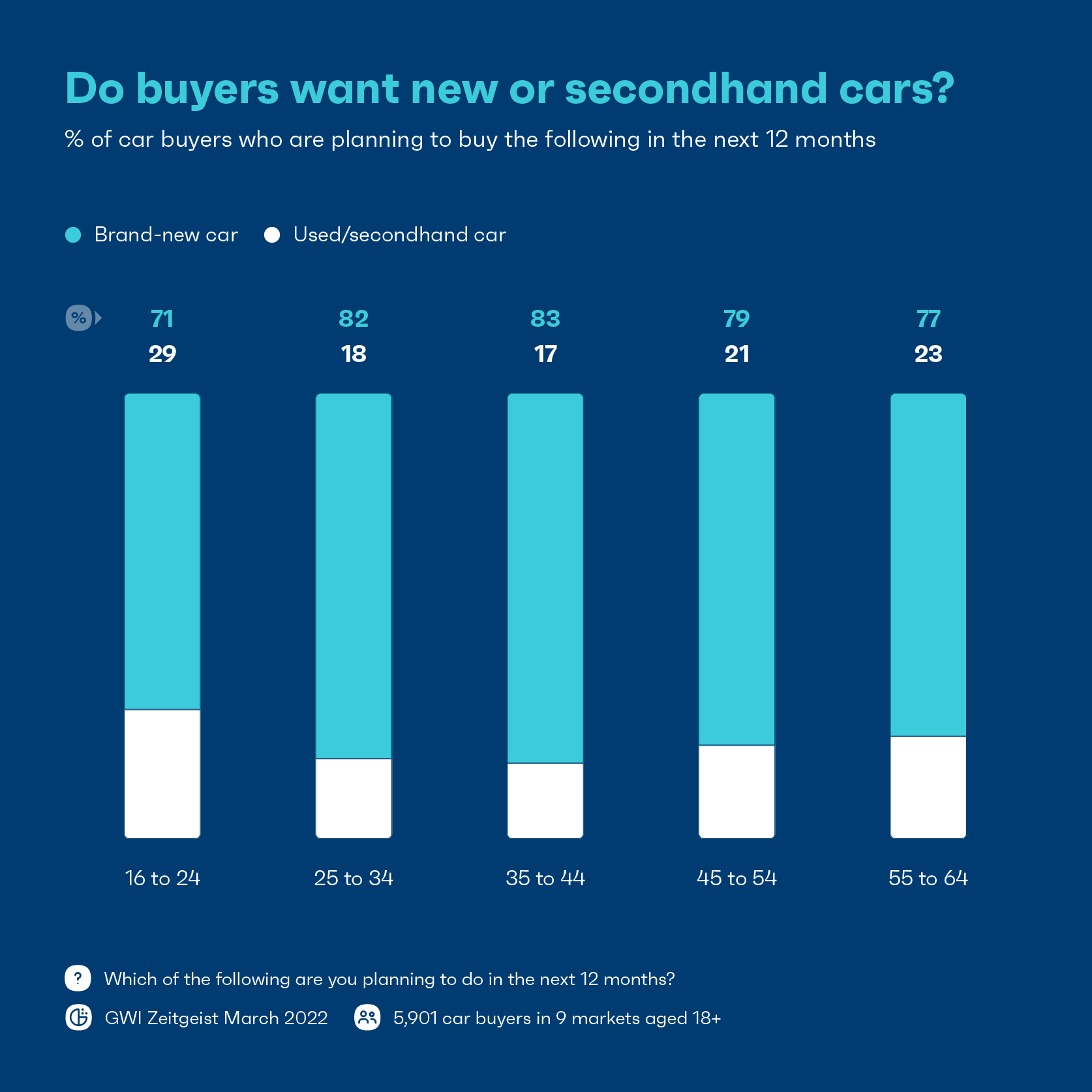Every now and again, a slow-burning trend picks up speed and accelerates. That’s exactly what’s occurring with electric vehicles, but it’s only one of the trends that we’re seeing in the automotive world.
The secondhand car market is at record highs in some countries, in part, due to delays in new cars coming off the production line. With stiff competition for car buyers’ attention, automotive marketers need to understand exactly who’s looking to buy, what they’re looking to buy, and what their purchase journey may look like.
Buckle up for the latest car buying trends you should know.
How has COVID affected car buying?
With the onset of the pandemic came a whole lot of uncertainty in the automotive market. Consumers’ focus was on stocking up on the essentials and staying safe, rather than what new car to put on their driveway. Not to mention chip shortages made new vehicles harder to find.
But even as mass vaccination programs rolled out and consumers’ financial outlook started to recover, car purchase intentions have still continued to decline. With many now negotiating a cost of living crisis, car purchases are unlikely to recover to pre-pandemic levels any time soon. That said, there are still great opportunities in the market for new and used car sales.

There’s huge demand for electric vehicles, and the secondhand market is at an all time high. There are still consumers of all ages after a fresh set of wheels. They might have miles on the clock, but they’re still new to the buyer.
So who might be looking to buy and why does it matter?
Is a new car the right car for you?
Across 9 markets, 80% of car buyers are planning to buy new in the next 12 months. It’s a sizable figure, but it doesn’t tell us the whole story.
In China and India, over 84% of car buyers surveyed are planning to buy new, whereas if you look at the UK/US, it’s a little over 3 in 5.
These consumers are buying because they want a more fuel-efficient car (17%), an electric/hybrid car (17%), and to replace their current vehicle (16%). Other factors such as wanting something more premium or spacious are only important to 1 in 10 new car buyers, with car prices less important still. Should that come as much of a surprise? Well if you look at what car buyers say about themselves … not so much.

Car buyers have money to spend, and stand out for describing themselves as affluent. They’re also a good reminder that a new car purchase is just as much about picking up new tech as it is getting from A to B. They also stand out for being confident with new technology, following the latest tech trends, and looking to buy tech products as soon as they’re available too.
With the latest waves of vehicles hitting the road being technology focused, and consumers keen to keep up, it’s a great opportunity for investors in this space to increase their profits.
Who’s buying secondhand cars?
Across 9 markets, 20% of car buyers are planning to purchase a secondhand car in the next 12 months. It’s a popular choice for many, with 45% of car buyers in the UK, 41% in France, and over a third in the US, choosing a pre-owned car over one fresh off the production line.
Where issues with supply affected new car sales, the secondhand market has looked to benefit. Numerous global lockdowns and staffing shortages have greatly disrupted global manufacturing and distribution, leading to a delay of new cars hitting the roads. The result? A sharp rise in demand for secondhand vehicles, with some markets increasing 30% year-on-year.
But increasing car prices isn’t really a good thing for secondhand buyers, as they’re a consumer group that’s less about luxury, and more about practicality.
Close to 2 in 5 secondhand buyers are from low-income backgrounds, a larger audience than medium or high earners. With cost of maintenance nearly 1.5x more important to secondhand buyers than those buying new, it’s clear many are feeling the pricing squeeze.
The electric vehicle market
You can hardly avoid electric vehicles in the news, and you’ll be seeing more plugged in as this quiet revolution hits the road.
For new car buyers, a full electric or hybrid vehicle is their number one reason to buy, and markets like the US are a great example of rising interest.
Tesla is growing in interest among US car buyers – and growing quickly. Year-on-year interest in buying a Tesla has increased 48%, which is the fastest growth of any automotive brand in the US market. It also follows a trend of American car buyers’ valuing local manufacturing when it comes to their new vehicle purchases.
Bearing in mind all the disruption in the past couple of years, the fact that interest in EVs continues to grow is a sign of how attractive they are to consumers. The switch to electric isn’t a novel choice, for many it’s an important step to help the environment.
For consumers in 9 markets, the switch to electric vehicles is a more effective measure to reduce environmental impacts than changing diets, or even reducing air travel.
Younger consumers see the advantages of switching to an electric motor vehicle, and are the most likely of all generations to see its importance. That said, it’s spending power that really comes into play here, as those in the high-income brackets are most likely to buy these higher priced vehicles.

Since Q4 2019, the number of high-income households owning an electric/hybrid vehicle has increased 42%, whereas for low-income households, there has been little-to-no change. This presents its own issues, as policy makers phase out the new sales of petrol/diesel cars, but component prices such as batteries are only rising.
As the market develops, buyers will have more model choices presented to them, at increasingly accessible price points. Car dealers making payment options more accessible through financing via monthly payments, an auto loan, or green discounts with dealers through government incentives, will all bring down the EV ceiling.
It’s probably too early to say that affordable electric vehicles will be hitting the road soon, let alone at scale, but the crest of the wave is certainly in sight.
Global searches on Google for electric cars and used electric cars reached their peak this year, so even if manufacturing is struggling to keep up the pace, search traffic certainly isn’t.
The 3 big takeaways:
- Consumers are less interested in buying cars, but that’s not stopping new car sales. Buyers of new cars are affluent and tech savvy, suiting the latest wave of vehicles hitting the market – good news for manufacturers looking to increase their profit per customer.
- Semiconductor shortages have created distribution challenges across the globe, but the secondhand market has sought to benefit. With used car buyers’ valuing the practicality of their vehicles, brand loyalty is less of an interest, while performance and cost are.
- The electric market continues to grow. Interest is rising year-on-year, and for new car buyers, the switch to electric is the main reason for pulling their wallets out to buy a new car.



